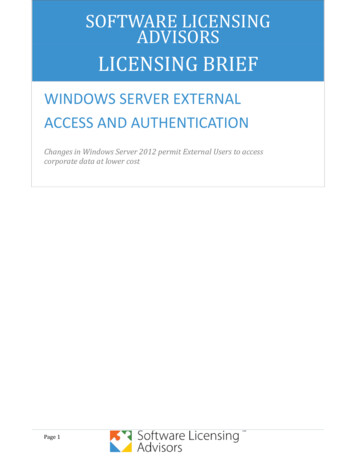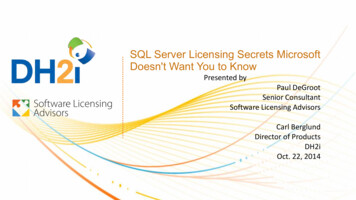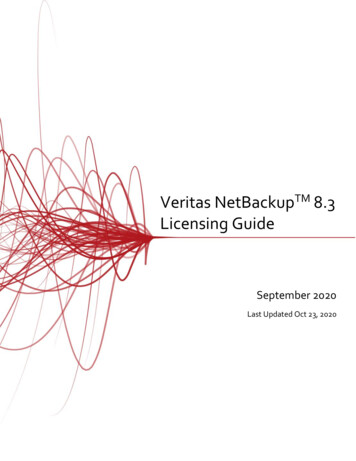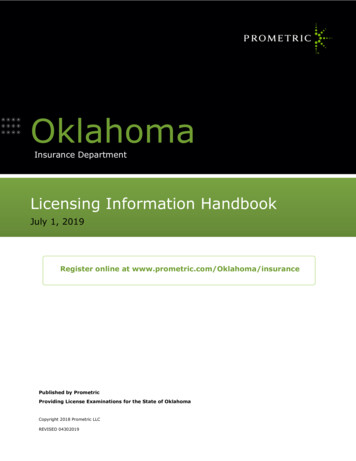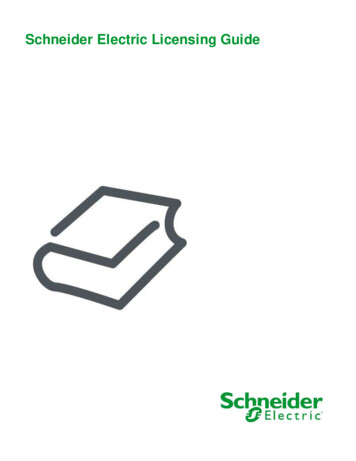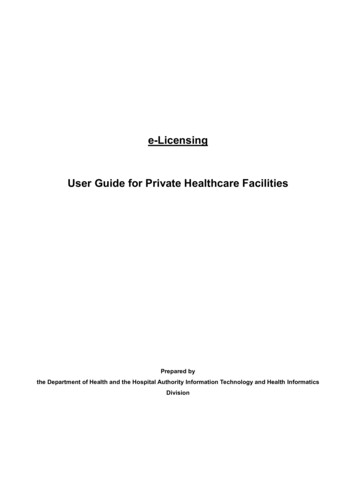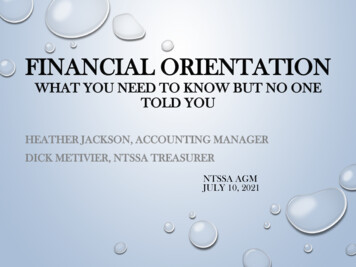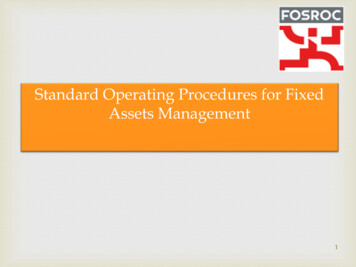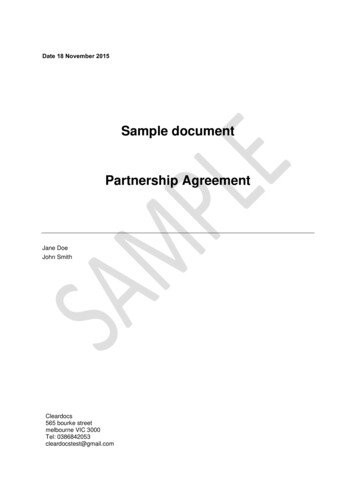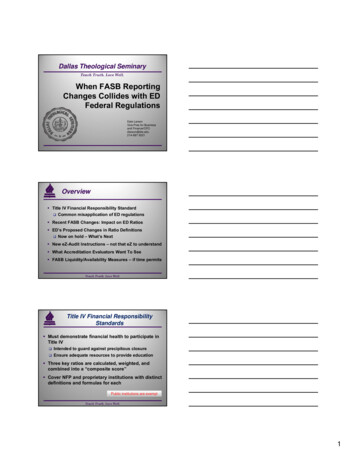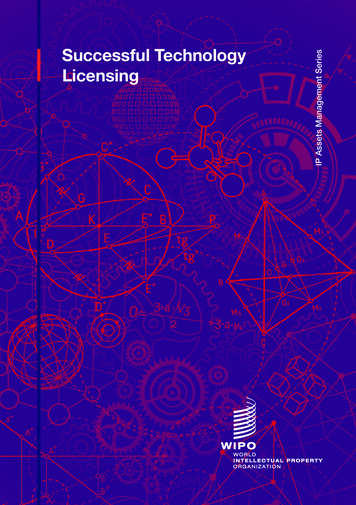
Transcription
IP Assets Management SeriesSuccessful TechnologyLicensing
2015IP Assets Management SeriesSuccessful TechnologyLicensing
IP Assets Management SeriesPrefaceIntellectual Property (IP) licensing is afrequently used means of exploitation ofIP, including in the process of commercialization of research results generatedin universities and publically funded research institutions. how to prepare for and negotiate a winwin licensing contract.In today’s knowledge-based economies,the prevailing model of IP collaborationamong academic and business organizations is “open innovation”, based onlicensing deals among various participating partners. Therefore, there is a growinginterest on the part of innovation stakeholders in the World Intellectual PropertyOrganization (WIPO) Member States inacquiring more practical knowledge aboutlicensing as a useful tool for transfer ofknowledge and IP.In the framework of the DevelopmentAgenda (DA) process – in particular, DARecommendations 7, 23 and 32 – WIPOMember States have requested more information regarding (a) the interface between Intellectual Property Rights (IPRs)and competition policies, (b) how to betterpromote pro-competitive intellectual property licensing practices and (c) informationon the links between IPRs and competitionpolicies. In response to this request, WIPOhas prepared this new, second edition ofthe STL Manual, with a new Cluster V on“Understanding Certain AnticompetitiveConcerns Related to Technology Licensing”,followed by concrete examples of pro-competitive licensing practices in the Annex II.This Successful Technology Licensing(STL) Manual was developed as a response to requests for a user-friendly manual aimed primarily at an audience of businesspersons, technology managers andscientists who are dealing with licensing inthe course of their work. Licensing occursin the context of various business andcollaboration relations, such as mergersand acquisitions, joint ventures, researchcollaboration agreements, joint researchand development arrangements, etc.This Manual focuses on issues essentialfor understanding licensing, including: the context in which licensing may occur; key terms of a licensing agreement andnegotiation methods; and2It is evolving material that can and shouldbe reviewed and improved in line with users’ needs.I wish to extend my appreciation to allwho provided guidance and commentsin the drafting of this work, in particular toMr. Patrick O’ Reilley, who edited the textand provided very valuable contributionsto this booklet on behalf of the LicensingExecutives Society International (LESI).Francis GurryDirector GeneralWIPO
Table of ContentsI.IntroductionII. Preparation for NegotiationIII. Key TermsIV. Conducting the NegotiationV.Understanding Certain Antitrust ConcernsRelated to Technology licensingVI. Using the Signed AgreementAppendix I & II3
Introduction4
Successful Technology LicensingThis text focuses on licensing as a meansof exploiting intellectual property (IP).Before examining the licensing processit is important to consider the contextin which licensing may occur. IP, as anasset to a business, may be exploited inmany ways. A business may acquire IP fordefensive purposes – using the IP to prevent copying of the businesses productsor service or to assert in response to an IPchallenge from another party. IP may alsobe used offensively – aggressively asserting it to frustrate competitors, obtain market share, control geographic markets, orgenerate revenue. Many businesses usetheir IP assets as leverage in negotiationsfor business deals, such as, for example,joint research and development arrangements, acquisitions or mergers, or strategic collaborations. Sophisticated businesses use IP for many different businesspurposes; basic licensing as discussed inthis text is only one way to exploit IP.The basic principles of licensing, as explained in this text, apply to most of themore complex methods of exploiting IP.A significant part of strategic collaboration, for example, is cross licensing of theparties’ IP so that each party can cooperatively develop, manufacture and marketproducts for their mutual benefit. Even aggressive assertions of IP against competitors, in most cases, end with a settlementin which the IP is licensed to the competitors. Learning the basics of licensing isa prerequisite to undertaking any of themore complex means for exploiting IP.An introduction to successful technologylicensing may be summarized by six fundamental and simple ideas.First: Technology licensing only occurs when one of the parties ownsvaluable intangible assets, known asIntellectual Property (IP), and becauseof that ownership has the legal right toprevent the other party from using it. A license is a consent by the owner to the useof IP in exchange for money or somethingelse of value. Technology licensing doesnot occur when there is no IP.However, IP is a broad concept and includes many different intangibles (e.g.patents (inventions), copyright (works ofauthorship including technical manuals,software, specifications, formulae, schematics, and documentation, among otherthings), know-how (e.g. expertise, skilledcraftsmanship, training capability, understanding of how something works), tradesecrets (a protected formula or method,undisclosed customer or technical information, algorithms, etc.), trademarks (logos, distinctive names for products andservices), industrial designs (the uniqueway a product looks such as a computer’s molding), and semiconductor maskworks (the physical design of semiconductor circuits).Second: There are different kinds oftechnology licenses. You will hear licenses referred to by many names, butit is useful to think of them in three categories. Licenses may be for certain IPrights only (e.g. a license to practice anidentified patent or to copy and distributea certain work of authorship). Licensesmay be for all the IP rights of any kind thatare necessary to reproduce, make, use,market, and sell products based on a typeof technology (e.g. a license to develop a5
IP Assets Management Seriesnew software product that is protectedby patent, copyright, trademark and tradesecret law).only when the negotiator understandsthoroughly the benefits that are availableto both parties.A license may also be for all the IP rightsnecessary in order to create and marketa product that complies with a technicalstandard or specification (e.g., a groupof enterprises has agreed on a technicalstandard to ensure interoperability of devices and owners of IP essential to practice the standard pool their IP rights andlicense to anyone who wishes to use thestandard on reasonable and nondiscriminatory terms).It is difficult to successfully negotiatea license where you wish to obtain therights to technology if you have little tooffer in return. Ideally, both sides to thenegotiation will have different elementsof value to offer, including, for example,skilled employees, a market that can becommercially exploited, know-how, research facilities and commitments, andsome form of IP.Third: Technology licensing occurs inthe context of a business relationshipin which other agreements are oftenimportant. These agreements are interrelated, whether they are in distinct documents or integrated in one big document.It is important to consider in a very practical way how the terms of these relatedagreements affect each other becauseof timing, pricing, and overall value. So,for example, to avoid future business disputes an agreement to develop a product(R&D agreement) should also addresswho has rights under pre-existing andnewly created IP rights (IP license), whowill have a licence to manufacture theproduct (manufacturing agreement),and,where appropriate, at what price one party will sell the product to the other party(sales agreement).Fourth: Technology licensing negotiations, like all negotiations, have sides(parties) whose interests are different, but must coincide in some ways.Successful technology licensing occurs6Unlike sales transactions involving physical property, IP licenses generally involvemore than the simple question: “howmuch?” The goal is to find a good balanceof value so that the license is a “win-win”transaction.Fifth: Technology licensing involvesreaching agreement on a complexset of terms, each of which has severalpossible solutions. Therefore, advancepreparation is essential. In advance of thenegotiation, before the other party hasbeen approached, a party may spendmany months defining business objectives, assessing leverage, researchingthe other party, deciding positions on keyterms, preparing documentation, and protecting IP, among other tasks.Sixth: Technology licensing is not necessarily synonymous with technologytransfer. The fact that two parties reacha deal on licensing does not mean thatthe subject matter of the deal is actuallytransferred. Because technology licensing concerns not only knowledge that is
Successful Technology Licensingexpressed in writing, but also knowledgein the form of practical know-how or tradesecrets (generally kept secret). It becomesan actual transfer when the licensor delivers the technology and knowledge to thelicensee and the licensee learns how toeffectively use, adapt and where possibleimprove the technology and knowledge.Ensuring the occurrence of knowledgetransfer should be one of the major concerns of negotiators, in particular thelicensees. Only when that occurs, an effective technology transfer takes place.7
II. Preparationfor Negotiation8
Successful Technology LicensingPreparation for technology licensing negotiation begins with the parties askingthemselves a series of questions. Thesequestions must be answered whether theparty is the licensor (the one who ownsthe IP and gives the license) or the licensee (the one who wants to use the IP andwishes to receive the license). Each partyshould ask itself the questions not onlywith respect to its own position, but alsowith respect to the probable position ofthe other party; each party will be in a better position for negotiations if it attemptsto understand the other party’s position.It is essential to ask and answer thesequestions before beginning technologylicensing negotiations.Ideally, what does each party want to obtain or provide: Assistance in using the IP (know-how)? Training? Development of technology or a product? Manufacturing rights or capabilities? A supply of products or equipment forsale or purchase? Multiple products? Investment in R&D or the party? Distribution of products or technologies? A license (consent) to use a patent orcopyrighted material or trade secret (orother IP) that belongs to the other party? A license to use a trademark or logo? A license that will enable you to complywith a technical standard or specification?A. What is the businessreason for this license?Each party must consider the license fromthe perspective of one receiving rights(license in), or giving rights (license out),or both receiving and giving rights (crosslicense)?How will this license agreement makemoney for each party?What must each party gain in order forthis agreement to be worthwhile?What is the best result that can be obtained for each party?What outcome does each party want toavoid?From a business perspective, is the best result for a party a license to IP rights only (pureIP license) or a broader set of relatedagreements (business partnership)?If this is a license in, will the licensee paymoney to the licensor? If this is a licenseout, will licensor receive money from thelicensee? Will there be money paid or received in a cross license? Is payment ofmoney the primary benefit/value that willbe provided in exchange for the license orare there other benefits/values?B. What leverage does eachparty have?Why does each party want or need thisagreement? What leverage does eachparty have that will make it more likelythan not that the other party will agreeto terms?9
IP Assets Management SeriesA party may have leverage if it is willing togive the other party favorable terms or below market terms, but generally leverageis some pressure or advantage outsidethe terms of the potential agreement. Need for money or investment. Need for new product to be competitive. Threat of litigation. Need to resolve dispute for customer. Required to license because of standardsetting obligation or to avoid competition law violation. Need for technology from the other party.Does either party have an alternative?Could a party negotiate more than onealternative deal at the same time?C. What is the time framefor signing the licenseagreement?Must it be completed in time for: A product launch? A press release? A trade show or conference? Beginning a research project? Commencement of manufacturing or sale? An investment or acquisition/sale transaction?Because use of IP in a development program can be infringement, it is risky to begin to work on a technology project beforea definitive agreement has been reached.Negotiating and signing a license agreement is an important step.Is it possible to reach agreement on all theissues at this time? Or, will unknown factsprevent reaching a definitive agreement?10Can the transaction be broken down intostages (e.g. interim agreement and thenfinal agreement, or multiple successiveagreements) without harming any party?What is a realistic schedule for negotiationmeetings, drafting, and execution of theagreement?D. What data anddocuments do you or theother party need?What specifications, protocols, publicinformation, product sheets, and patentabstracts and texts, and all other information are relevant to the technology?Put them in notebooks organized so thatthey are easy to refer to, and if voluminous,index them.What information related to the businessof the other party do I need (e.g. publicinformation on revenues, employees, financial history, technology press releases,website information, etc.)? Put this information in a notebook, too.What information do I have related to alternative parties?What other agreements am I aware of thatmay be similar to this agreement? Gathersamples and forms of agreements thatseem relevant to this transaction.
Successful Technology LicensingE. Who is on the negotiatingteam?your use only and the use of your team.The external version is a version of theterm sheet that will be given to the otherDecide who will participate in the nego- party in the negotiation as an aid to reachtiation representing your side (the team).ing agreement.Who will be the principal spokesperson?Who will be present in the negotiation, butin a supporting or secondary role?Who will have authority to decide issuesthat arise?Who will need to be consulted aboutpractical issues that arise (e.g. how muchmoney can be spent, what commitmentscan be made to technical service, whattechnical requirements there are, etc.)?Who will be the legal counsel?Who will be responsible for drafting theagreement or responding to drafts andchanges from the other side?F. What are your positionson the key issues of thelicense?The key issues (or terms) are the importantbusiness and legal terms of the license.The key issues for a technology licenseare discussed in the next Section (III). Thebest way to work through and decide yourposition on the key issues is to use a termsheet.A term sheet is a short outline (no morethan two pages) of the key terms of thelicense, concentrating on the “businessterms”. It has an internal version and anexternal version. The internal version is forA term sheet is not the same as aLetter of Intent or a Memorandum ofUnderstanding (See Section H. below;these are not recommended). A termsheet is not a short agreement. It is a listof the key terms with a tentative statementof your position written under each keyterm. It has many important functions.Because the laws of some countriesmay make the external version of a termsheet (the one given to the other party)enforceable in the event negotiations fail,every term sheet should be marked witha legend that disclaims any agreement orany obligation to negotiate and that statesonly a definitive agreement signed by bothparties will be enforceable. At a minimum,applicable laws may require the partiesto a term sheet to negotiate in good faith.Because the effect of a term sheet varies depending on applicable law, everyterm sheet involving parties from differentcountries should include a choice of law.The most important work of a term sheet isto help sort through the many complex issues in a technology license and make surethat you don’t miss any. It helps spot problems (e.g. you realize that you are not surewhether you need the right to modify thetechnology and you believe that the otherparty has a strong policy against grantinga right to modify). It also helps communicate within the team so that consistentpositions are taken, avoiding the embarrassing experience of having different11
IP Assets Management Seriesteam members say different things in thenegotiation session. If legal counsel is notpresent in the negotiation, the term sheetis an invaluable tool in communicating withhim or her. It is used to make sure that thepositions that you plan to take are in factauthorized and practically feasible (e.g. youfind out that you planned to agree to provide service and support, but you find outthat your enterprise does not have enoughpersonnel). Finally, it helps the team keeptrack of the objectives of the negotiation.Use a form term sheet, such as the onein the Appendix to this booklet, and gothrough each issue. Decide what you thinkthat your position should be on each keyterm based on your business objectiveswith this technology license. You will wantto think of fallback positions and whetherit will be possible to compromise on eachkey term. Write all of this down on the termsheet using plain, non-legal language.Circulate the term sheet internally (withinyour party only) on a confidential basis topersons who must be consulted to obtaininternal clearance and obtain reactions,suggestions, approval. Show it to the legalcounsel and obtain his or her edits andcomments.G. What is your negotiatingstrategy?Confer with the team about the answersto the following questions.ideal position. This is written in the external term sheet.For each term in the term sheet, what isyour “bottom line”? This refers to the setof terms that, from your side’s perspective, must be agreed or the objectives ofthe agreement will not be achieved. Thebottom line is not disclosed until late inthe negotiation, if ever. This is not written in the internal term sheet because ofthe importance of confidentiality of theseterms. The bottom line should not changedramatically in the course of negotiations.What are the other party’s first line andbottom line likely to be?Use your internal term sheet throughout asa guide to the negotiation and as a communication tool for your negotiating team.What are the alternatives if your bottomline cannot be gained?H. Will you need preliminaryagreements?Confidentiality agreements (non-disclosure agreements) are often importantto protect business and technical disclosures that are made during the negotiations. Indeed, where the technology underconsideration is proprietary, the potentiallicensee may wish to evaluate the technology in advance of negotiation; such evaluation may be performed under a limitedconfidentiality agreement.For each term in the term sheet, what isyour “first line”? This refers to the set of Interim agreements, feasibility agreeterms that are first set forth in the nego- ments and prototype agreements.tiation and represents an aggressive or These are sometimes useful when you12
Successful Technology Licensingneed more information in order to knowwhether a technology license would be agood idea. The key terms in such agreements are generally that each side willbear its own expenses, or that one sideor the other will pay certain expensesor provide equipment or data, who willown any IP used or created, who will dowhat work, prototype creation, or testing, confidentiality (see above) and thatthe agreement will end by a certain date(usually very short term-weeks or months).Such short-term agreements should notbe used as substitutes for the technologylicense or other agreements.What are likely to be the other side’s positions on each key term?Meet with the team to discuss andanswer the questions set forth inthis Section and in Section III belowbefore the first meeting with theother party. This communicationavoids misunderstanding aboutthe basic objectives and terms ofthe license, and is an importantcomponent in technology licensing.Do not use Letters of Intent orMemoranda of Understanding. Theseare not agreements, but are often vaguestatements of intentions and plans for thefuture. These are not useful because theyare insufficiently concrete for businessobjectives, and cause confusion as towhether they are legally binding.Standstill agreements or agreements tonegotiate on an exclusive basis are almost never desirable and should generally be refused. They can give an undueadvantage to one side in a negotiationand remove the option of turning to analternative if negotiation is not successful.I. What are the strongpoints and objectives of theother team?What are the strengths of the other side’s negotiating representatives?Do the representatives who are communicating with you have authority to makedecisions?13
III. Key Terms14
Successful Technology LicensingThe issues that are agreed upon in a li- CLUSTER ONE:cense agreement are called the “terms” THE SUBJECT OF(or “material terms” or “terms and con- THE LICENSEditions” or “provisions”). What makestechnology licensing complex is that there 1.1 What is the subjectare more key issues in such agreements matter of this license?than in most other types of agreements.Also, for each key issue, there are many This cluster of issues relates to the defipossible variations for how the issue can nition of the technology that is being libe resolved. The successful negotiator censed. This may sound obvious, but itkeeps a mental and written checklist of is an underestimated issue that can givethese key terms and the several variations rise to disputes after the agreement hason each that will be acceptable to him. He been signed.also knows what variations on each keyterm are disadvantageous or risky.Is the technology that you want to usea product, a formula, a specification, aAlthough the key terms vary somewhat protocol, a software program, a set ofdepending on what sort of technology is diagrams or documentation? If so, it isbeing licensed (e.g. computer software, a essential to describe this precisely. Or dosemi-conductor invention, a pharmaceuti- you need a license to practice a specifiedcal formula, etc.), similar issues arise in all patent or set of patents? Or is the subjecttransactions in which a technology con- matter of the license all the IP and technoltaining intellectual property rights is being ogy required in order to meet a specifiedlicensed. The purpose of this section is to standard (standards licensing)?give you an overview of these key terms.1Note well that this is not an exhaustive list The licensor’s interest is in narrowing theof material terms but rather an introduction definition of what is being licensed. Theto some of the issues that frequently arise. licensee’s interest is in having a broaddefinition of the technology, although theTo simplify, the key terms are grouped into licensee must consider the basis for payfour “clusters”. It is useful to think of the ments under the agreement that often iskey terms in this way, and then to mentally coextensive with the scope of the license.break them down into smaller headings In some cases, both sides will seek refugewithin each cluster.2in ambiguity about the technology for anumber of reasons. In some cases, nego1Note that this document is not intended as atiators have not communicated well withsubstitute for legal advice. It is essential in any tech- other segments of their business and arenology licensing negotiation to retain legal counsel.either not sure what state the technologyThis list will familiarize you with the issues so that youcan communicate effectively with your legal counsel.is, or are not clear to what use the tech2From now on in this Section, it will be asnology will be put.sumed that the negotiation involves a license In, butexcept where indicated the same comments applyconversely to a license out.15
IP Assets Management SeriesSometimes, the lack of clarity in an agree- more specific references to the naturement about what is licensed is because and definition of the subject matter (e.g.people do not want to admit that they do The so and so technology, as more fullynot understand exactly how technology described in Exhibit A). Make sure thatworks; they think that they should know. Exhibit A is filled in and what is written isHowever, it is often not possible to learn clear and specific enough. Also, do notabout the exact nature of technology wait until late in the negotiations to obtainbased on public records. Part of the ne- this information. If Exhibit A refers to agotiation is finding out exactly what the specification or some other written doctechnology is and what part of it you ument, read it carefully to see if it clearlyneed to use for your business (see Issue describes what is being licensed. The de1.4 below).scription should be clear enough so that,in case of a dispute, a third party who isYou may save money if you only license not knowledgeable about the technolowhat you need in order to make your busi- gy could make a decision about what isness use of the technology successful.included and what is not. References to“version A” of the software may be suffiIt is important to communicate with ciently clear if you have a copy of versionyour business colleagues to see what A and have already inspected it or a copythey need in order to make effective is deposited in escrow for your benefit. Inbusiness and technological use of the some cases, you will be able to attach thetechnology. Do they need only a patent actual thing that is being licensed to thelicense? Or do they need the rights to use agreement (e.g. a copy of the software).a particular product or technology thatpractices the patent? Do they need de- 1.2 Is the thing that is beingtailed documentation or schematics? Do licensed completed?they need source code or is object codesufficient? What version of the software Is the software completely written, thewill they need? Do they require test data? hardware design completed and impleDo they require samples or prototypes? mented in the form in which you need it, is(See Cluster 4, Issue 4.1 below). Will they customization required to make the subneed “know-how”, or training in order to ject work with your technology or systems,use the technology? (See Cluster 4, Issue is a “port” needed, is research and devel4.3 below).opment continuing? The same questionsapply in other fields: is the technique comBeware of licensing technology for pletely developed, is the invention fully enwhich there is no clear written specifi- abled, and is the pharmaceutical processcation or other documentation. Do not fully developed?accept vague references to the subjectmatter such as “the state of the art XXX If there is more work to be done, detertechnology”. It is common to refer to an mine whether the completion of this workexhibit attached to the agreement text for is important to you as a condition of the16
Successful Technology Licensingdeal. Can you live with the technology in good faith efforts” or “fully operational”.an incomplete form (e.g. partially written These terms are so vague that they causesoftware, incomplete formulation or test business misunderstandings and legalof a drug)? If it is left incomplete, will the disputes. For example, in some counagreement permit you or your designee tries the term “best efforts” is construedto complete and/or modify the technolo- to mean what is reasonable under the cirgy? See Cluster 2 below which discusses cumstances, while in other countries thewhat the licensee is permitted to do to the same term is construed to require doingtechnology.everything that is possible. Instead of using a phrase having vague and variableConversely, if you are the one licensing meanings, define in the agreement exactout the technology, make sure that it is ly what steps would satisfy the intendedclear whether you are expected to have “best efforts.”fully completed it by the time of executionof the agreement. Does it have to pass If the subject matter of the license is trulyacceptance testing? Does it have to meet in a state of development, or if major worka specification or a functionality test? needs to be done, such as a port to aDoes it have to perform certain functions different platform, it is advisable to haveat specified performance levels in order a separate or attached developmentfor you to be paid?agreement with clear deliverables, assignments of responsibility, performanceThe best position for the person who and function standards, and timetables.is licensing technology out is that thesoftware or other technology need 1.3 Who owns the IP thatnot live up to any particular standard underlies the technology?of performance or function. In this case,the technology licensor is providing some Does the licensor own what he or she isbasic rights to the technology, but is really licensing to you? Does he or she have theproviding his or her time and effort and a right to license it? Does he or she have thepermission to use the technology as is. right to license all other technologies thatThis is obviously not good for the person are needed to make the licensed technolwho is licensing the software, unless the ogy work?price (royalties) and other terms reflectthis. The best position for the person
A license that will enable you to comply wtih a technci al standard or specfici atoi n? Each party must consider the license from the perspective of one receiving rights (license in), or giving rights (license out), or both receiving and giving rights (cross license)? If this is a license in, will the licensee pay money to the licensor?
